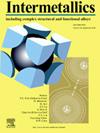Microstructure evolution and its effect on high-temperature compressive properties of directionally solidified Ti-44.5Al-3Nb-0.6Si-0.2C alloy by electromagnetic confinement after heat treatment
Abstract
To regulate the microstructure of directionally solidified TiAl alloy and improve its service temperature and high-temperature mechanical properties, the large-size single crystal Ti-44.5Al-3Nb-0.6Si-0.2C alloy with full lamellar structure prepared by electromagnetic confinement directional solidification was heat-treated in the α single-phase region. The results show that this alloy has high stability and no recrystallization occurs at 1340 °C for 30 min. The (α2+γ) lamellar structure formed during the subsequent cooling process is consistent with the orientation of the original as-cast state, and the refinement effect is very significant. The thickness of the α2 and the γ phases is 1/3 and 1/10 of the original structure, respectively. The dislocation strengthening and the interface strengthening are enhanced with the increase of the dislocation density and the number of α2/γ phase boundaries in the refined lamellar structure after heat treatment, thus resulting in a substantial increase of compressive strength at 1000 °C. The corresponding compressive peak strength at 1000 °C is 2.6 times higher than that of the as-cast alloy, reaching 709 MPa. This exceeds almost all the TiAl alloys under the same conditions reported so far. This research is expected to increase the service temperature of TiAl alloy to 1000 °C, thereby replacing more Ni-based superalloy components and promoting the lightweight development of aero engines.

 求助内容:
求助内容: 应助结果提醒方式:
应助结果提醒方式:


